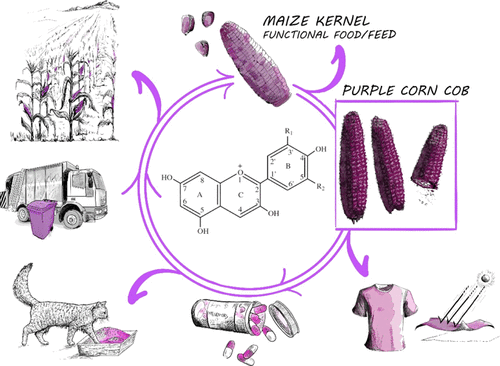当前位置:
X-MOL 学术
›
ACS Sustain. Chem. Eng.
›
论文详情
Our official English website, www.x-mol.net, welcomes your
feedback! (Note: you will need to create a separate account there.)
Biorefinery Approach Applied to the Valorization of Purple Corn Cobs
ACS Sustainable Chemistry & Engineering ( IF 7.1 ) Pub Date : 2021-02-26 , DOI: 10.1021/acssuschemeng.0c08717 Patrizia De Nisi 1 , Giulia Borlini 2 , Parisa Abbasi Parizad 1 , Alessio Scarafoni 3 , Piero Sandroni 4 , Elena Cassani 2 , Fabrizio Adani 1 , Roberto Pilu 2
ACS Sustainable Chemistry & Engineering ( IF 7.1 ) Pub Date : 2021-02-26 , DOI: 10.1021/acssuschemeng.0c08717 Patrizia De Nisi 1 , Giulia Borlini 2 , Parisa Abbasi Parizad 1 , Alessio Scarafoni 3 , Piero Sandroni 4 , Elena Cassani 2 , Fabrizio Adani 1 , Roberto Pilu 2
Affiliation

|
The increased demand for textile products and the use of synthetic dyes have contributed to making dye wastewater one of the main causes of severe pollution problems. The use of natural dyes is therefore attracting big interest among the dyeing industries. Besides this, natural pigments need to be of low cost, with implications for the extraction methods used. Recovering pigments from waste materials and proposing a biorefinery approach can be a solution, reducing total costs and increasing the total revenue, within the green economy. This work reports a biorefinery approach to recover anthocyanins by setting up a quick and cheap extraction method, starting from dried purple corn cobs, to obtain pigments used to dye natural fibers. The residues of the cobs were extracted, recovering anthocyanins for nutraceutical purposes. The exhausted residue was proposed as animal bedding, closing the loop with zero waste produced, that is, residual animal bedding is collected with food waste, producing compost and/or biogas and fertilizers. Water extraction allowed the recovery of 36.3% of anthocyanins, mainly composed of cyanidin derivatives (glycosylated and mainly monoacylated). The use of the first extract to dye fabrics gave good results in terms of color strength and fastness. The subsequent extraction with ethanol allowed the recovery of additional 33.2% of residual anthocyanins. The anthocyanin-rich extract exhibited very good anti-inflammatory activity with high nutraceutical potential. Residual exhausted ground-up cobs are recommended to be used as animal bedding since the fiber content and water retention ability were very similar to those of a homologous commercial product. Moreover, the residual anthocyanins (183 ± 15 mg 100 g–1), recalcitrant to extraction, conferred interesting properties to the proposed animal bedding.
中文翻译:

生物精炼方法在紫色玉米芯的价格平衡中的应用
对纺织产品的需求增加以及合成染料的使用,使染料废水成为严重污染问题的主要原因之一。因此,天然染料的使用在染色工业中引起了极大的兴趣。除此之外,天然颜料需要低成本,这涉及所用的提取方法。在绿色经济中,从废料中回收颜料并提出生物精炼方法可能是一种解决方案,可以降低总成本并增加总收入。这项工作报告了一种生物精炼方法,该方法通过建立一种快速且廉价的提取方法来回收花色苷的方法,该方法从干燥的紫色玉米芯开始,以获得用于染色天然纤维的颜料。提取了穗轴的残留物,回收了花青素以用于营养保健用途。提议用尽的残留物作为动物垫料,使生产零废物封闭循环,也就是说,将剩余的动物垫料与食物垃圾一起收集,产生堆肥和/或沼气和化肥。通过水萃取可以回收到36.3%的花色素苷,该花色素苷主要由花青素衍生物(糖基化和主要单酰化)组成。在颜色强度和坚牢度方面,使用第一提取物对织物进行染色可获得良好的结果。随后用乙醇萃取可回收另外33.2%的残留花色苷。富含花青素的提取物表现出非常好的抗炎活性,具有很高的保健潜力。由于纤维含量和保水能力与同源商品的纤维含量和保水能力非常相似,因此建议将残留的残留磨碎的玉米芯用作动物床上用品。此外,残留的花青素(183±15毫克100克–1),难以提取,为拟议的动物床上用品赋予了有趣的特性。
更新日期:2021-03-15
中文翻译:

生物精炼方法在紫色玉米芯的价格平衡中的应用
对纺织产品的需求增加以及合成染料的使用,使染料废水成为严重污染问题的主要原因之一。因此,天然染料的使用在染色工业中引起了极大的兴趣。除此之外,天然颜料需要低成本,这涉及所用的提取方法。在绿色经济中,从废料中回收颜料并提出生物精炼方法可能是一种解决方案,可以降低总成本并增加总收入。这项工作报告了一种生物精炼方法,该方法通过建立一种快速且廉价的提取方法来回收花色苷的方法,该方法从干燥的紫色玉米芯开始,以获得用于染色天然纤维的颜料。提取了穗轴的残留物,回收了花青素以用于营养保健用途。提议用尽的残留物作为动物垫料,使生产零废物封闭循环,也就是说,将剩余的动物垫料与食物垃圾一起收集,产生堆肥和/或沼气和化肥。通过水萃取可以回收到36.3%的花色素苷,该花色素苷主要由花青素衍生物(糖基化和主要单酰化)组成。在颜色强度和坚牢度方面,使用第一提取物对织物进行染色可获得良好的结果。随后用乙醇萃取可回收另外33.2%的残留花色苷。富含花青素的提取物表现出非常好的抗炎活性,具有很高的保健潜力。由于纤维含量和保水能力与同源商品的纤维含量和保水能力非常相似,因此建议将残留的残留磨碎的玉米芯用作动物床上用品。此外,残留的花青素(183±15毫克100克–1),难以提取,为拟议的动物床上用品赋予了有趣的特性。









































 京公网安备 11010802027423号
京公网安备 11010802027423号